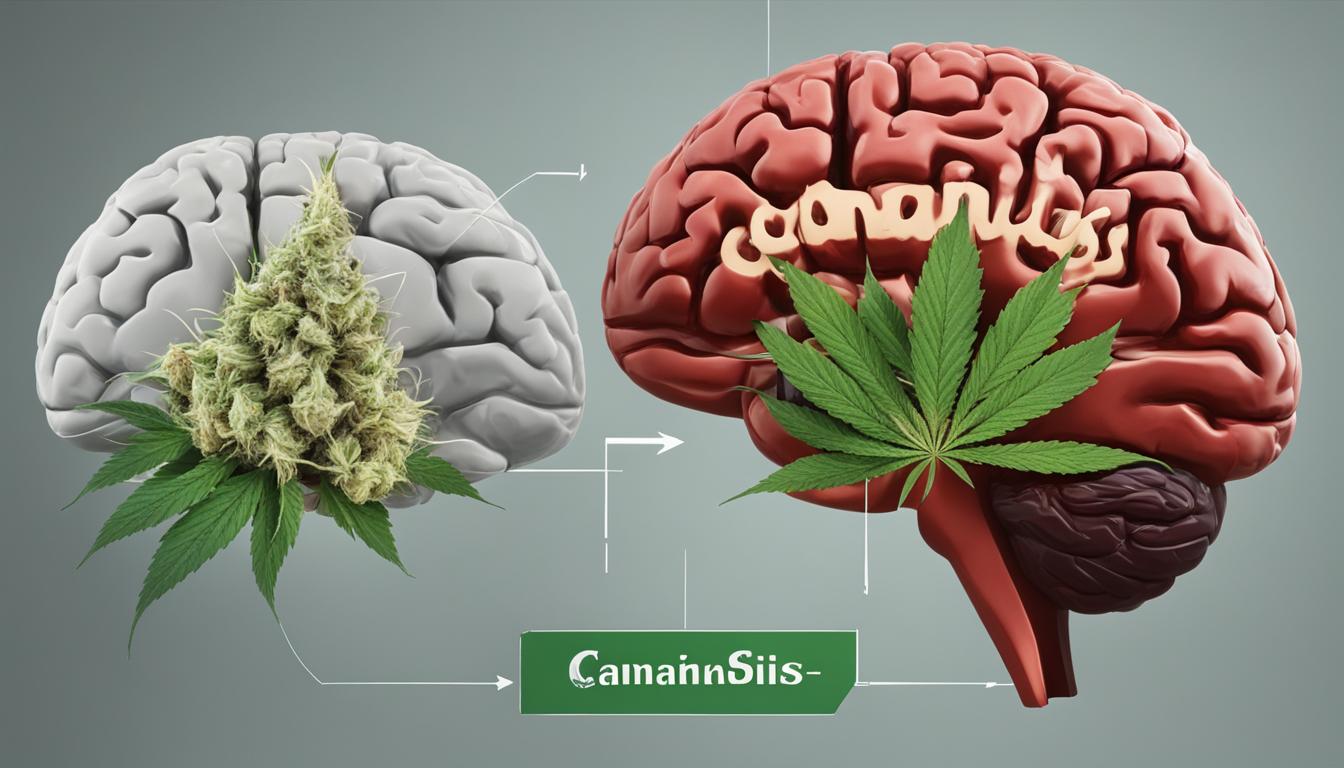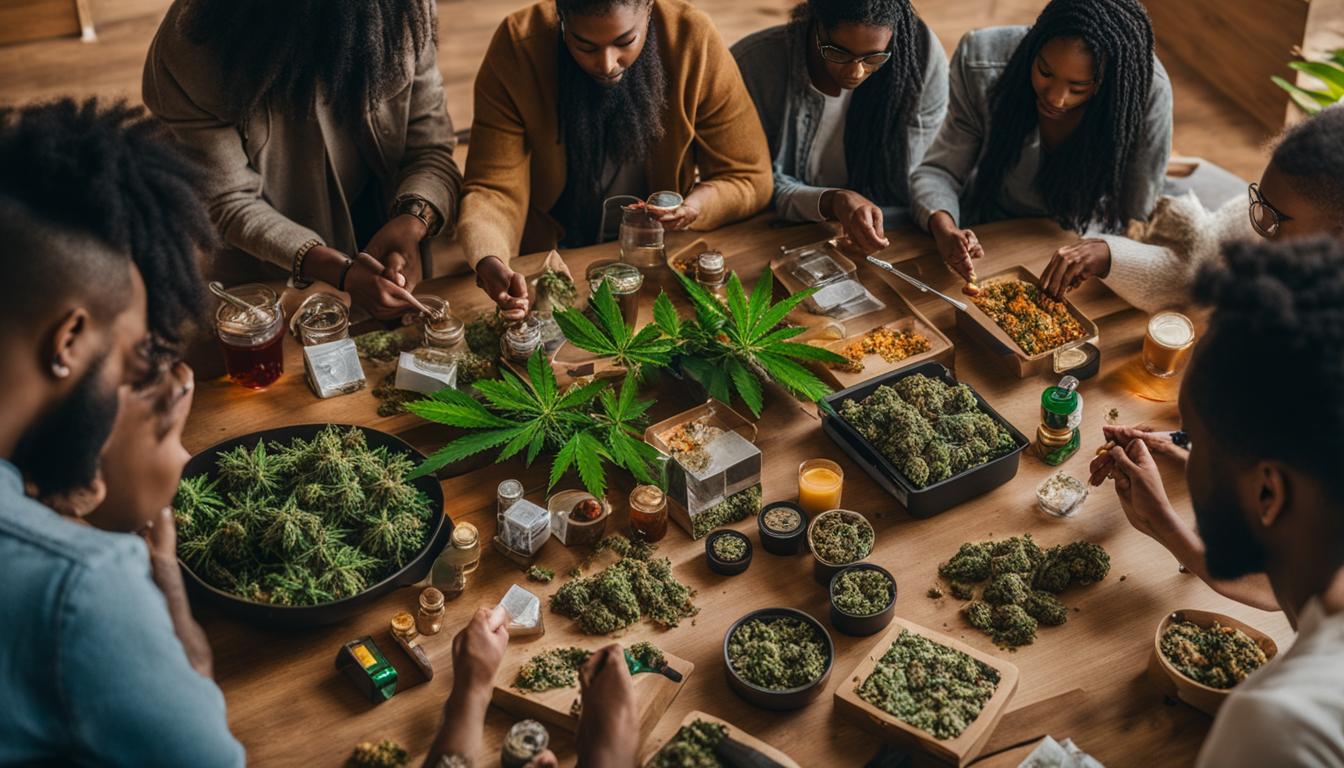Uncategorized
Clearing Myths: Debunk Cannabis Misconceptions
As a passionate advocate for evidence-based information, I feel compelled to address the misconceptions and myths that surround cannabis. With its increasing prevalence in mainstream culture and evolving legal landscape, it is crucial to separate fact from fiction when it comes to this fascinating plant.
Throughout this article, I will debunk some of the most widely held misconceptions about cannabis, providing you with factual information and scientific evidence to counter these myths. Let’s dig deep into the world of cannabis research and unravel the truth behind the haze of misconceptions.
Key Takeaways:
- Understanding the facts about cannabis is essential for informed decision-making.
- Scientific research and evidence can debunk common misconceptions about marijuana.
- Cannabis has medicinal potential supported by a growing body of evidence.
- Misunderstandings about addiction and cognitive function relate to responsible cannabis use.
- Various strains and consumption methods offer different effects and options to users.
Dispelling the Gateway Drug Myth
Contrary to popular belief, extensive research has disproven the idea that marijuana acts as a gateway drug, leading to the use of more harmful substances. Studies from the National Institute on Drug Abuse (NIDA) have found that most marijuana users do not progress to using harder drugs. Individual predispositions and social environment play a larger role in determining drug use patterns than marijuana itself.
While it is true that some individuals who use marijuana may go on to use other drugs, the notion that marijuana use inherently leads to addiction and the use of more dangerous substances is unfounded. According to the NIDA, the majority of marijuana users do not develop a cannabis use disorder or move on to using substances like cocaine or heroin.
“The hypothesis that marijuana use is causally linked to the subsequent abuse of other illicit drugs…is not supported by substantial empirical evidence.”
Many factors contribute to drug use and addiction, and it is crucial to consider social, environmental, and individual factors in understanding substance abuse. Research has shown that individuals with certain risk factors, such as a history of trauma, mental health disorders, or a family history of addiction, are more likely to engage in drug use and develop addictive behaviors.
Furthermore, social factors play a significant role in drug use. Peer influence, socio-economic conditions, and the availability of drugs in a specific community can all impact an individual’s drug use trajectory. It is important to address the underlying factors contributing to drug use rather than solely blaming marijuana as a gateway drug.
The Role of Cannabis Research in Debunking the Gateway Theory
Over the years, numerous studies have examined the relationship between marijuana use and the progression to other drugs, offering valuable insights into the gateway theory. One notable research initiative is the Adolescent Brain Cognitive Development (ABCD) study, a long-term investigation led by NIDA, which aims to understand the impact of substance use on the developing brain.
The ABCD study, involving thousands of participants, has consistently found that marijuana use alone does not cause individuals to escalate to using more potent substances. It has also revealed that other factors, such as peer influence, mental health conditions, and genetic predispositions, have a significant influence on an individual’s drug use trajectory.
In combination with anecdotal evidence and the voices of individuals who have used marijuana but not progressed to harder drugs, the research findings collectively challenge the notion of marijuana as a gateway drug.
The image above visually highlights the perspective shift in understanding the marijuana gateway drug theory, emphasizing the role of social factors in drug use.
| Myth | Reality |
|---|---|
| Marijuana use leads to the use of harder drugs. | Most marijuana users do not progress to using more dangerous substances. |
| Individuals who use marijuana are more likely to become addicted to drugs. | Individual predispositions and social environment play a larger role in addiction than marijuana itself. |
| Marijuana acts as a gateway to addiction. | Drug use patterns are influenced by various socio-economic and individual factors. |
The table above summarizes the key misconceptions associated with the gateway drug theory and presents the realities supported by cannabis research.
Addressing Addiction Misconceptions
It is important to address common misconceptions about cannabis addiction to provide accurate information and promote responsible use. While it is true that some individuals may develop a dependence on cannabis, it is essential to understand that the risk of addiction is lower compared to substances such as alcohol, nicotine, or opioids.
Research has shown that only a small percentage of marijuana users experience withdrawal symptoms when they stop using the drug, and these symptoms are typically less severe than those caused by other addictive substances. This indicates that cannabis dependence is less significant and debilitating compared to the dependence associated with substances like alcohol or opioids.
It is worth noting that addiction is a complex issue influenced by various factors, including biological, psychological, and environmental factors. While cannabis addiction exists, it is essential to put it into perspective and compare it to the addictive properties of other commonly consumed substances. This comparative analysis will shed light on the actual risks associated with cannabis dependency.
Research has consistently shown that cannabis addiction ranks below alcohol, nicotine, and opioids in terms of addictive potential and withdrawal severity. This emphasizes the importance of looking beyond stereotypes and understanding the nuances of cannabis addiction.
To better understand how cannabis addiction compares to other addictive substances, let’s explore a comparative table:
| Substance | Addictive Potential | Withdrawal Severity |
|---|---|---|
| Cannabis | Medium | Mild to Moderate |
| Alcohol | High | Severe |
| Nicotine | High | Severe |
| Opioids | High | Severe |
This table highlights the relatively lower addictive potential and withdrawal severity associated with cannabis when compared to alcohol, nicotine, and opioids. It is essential to consider these differences when discussing cannabis addiction and making informed decisions about its use.
By providing accurate information about cannabis addiction and dispelling misconceptions, we can contribute to responsible discussions and help individuals make informed choices regarding cannabis use.

Unveiling the Medicinal Potential of Cannabis
Despite the previous classification of cannabis as a Schedule I substance with no recognized medicinal purpose, extensive research has revealed the diverse medical uses of cannabinoids such as THC and CBD. The medicinal benefits of cannabis have been demonstrated in various conditions and symptoms, opening up new possibilities for treatment.
One area where cannabis has shown promise is in the management of multiple sclerosis. Studies have suggested that cannabinoids can help alleviate symptoms such as muscle spasticity, pain, and sleep disturbances. By targeting the body’s endocannabinoid system, cannabis may provide relief and improve the quality of life for individuals living with multiple sclerosis.
Epilepsy, a neurological disorder characterized by recurrent seizures, has also been a focus of research into the medicinal applications of cannabis. Studies have shown that certain strains of cannabis, particularly those high in CBD, may help reduce the frequency and severity of seizures in individuals with epilepsy. This has led to the development of FDA-approved medications, such as Epidiolex, which contain CBD and are used to treat certain types of epilepsy.
In addition to neurological conditions, cannabis has shown promise in the management of chronic pain. Whether it be pain associated with conditions such as arthritis or cancer-related pain, cannabinoids have been found to have analgesic properties. By interacting with the body’s pain receptors, cannabis can provide relief and improve the quality of life for individuals experiencing chronic pain.
Furthermore, cannabis has been recognized for its potential in alleviating side effects associated with chemotherapy. Cancer patients undergoing chemotherapy often experience nausea, vomiting, loss of appetite, and pain. Studies have shown that cannabis, particularly strains high in THC, can help reduce these symptoms and improve overall well-being. By providing relief from the side effects of chemotherapy, cannabis may enhance the tolerability and effectiveness of cancer treatment.
Medical Uses of Cannabis:
- Managing symptoms of multiple sclerosis
- Reducing seizures in epilepsy
- Alleviating chronic pain
- Relieving side effects of chemotherapy
As more research emerges, it is becoming increasingly evident that cannabis has significant potential as a therapeutic agent. However, it is essential to consult with medical professionals and adhere to the appropriate legal frameworks when considering the use of cannabis for medical purposes.
The above image illustrates the potential of cannabis in medical treatments, highlighting its ability to provide relief and improve the quality of life for individuals with various medical conditions.
Dispelling IQ and Cognitive Function Myths
It is often believed that marijuana use, particularly among young individuals, can have detrimental effects on IQ and cognitive function. However, extensive research suggests that responsible and moderate marijuana use in adults does not significantly impair cognitive function in the long term.
While there is some evidence to suggest that heavy and prolonged marijuana use during adolescence may impact brain development to some extent, these effects are typically reversible and tend to return to normal once marijuana use ceases.
“Research indicates that responsible marijuana use in adults does not significantly impair cognitive function in the long run.”
Multiple studies have been conducted to investigate the supposed link between marijuana and IQ. One such study, published in Proceedings of the National Academy of Sciences, followed a large sample of individuals from childhood to adulthood and found that marijuana use was not associated with a decline in IQ scores when factors such as socioeconomic status and alcohol use were taken into account.
Additionally, a meta-analysis published in JAMA Psychiatry examined the combined results of 69 studies and found no significant impact of marijuana use on cognitive function in adults.
It’s important to note that the potential effects of marijuana on brain development and cognitive function should be considered in the context of various factors, such as the age of initiation, frequency and duration of use, and individual vulnerabilities. The available evidence suggests that responsible marijuana use in adults is unlikely to cause significant long-term cognitive impairment.
Effects of Marijuana on Brain Development
While responsible marijuana use by adults may not pose significant risks to cognitive function, the same cannot be said for heavy and prolonged use during adolescence. The developing brain is more vulnerable to the effects of marijuana, and studies have shown that early and frequent marijuana use during adolescence can lead to alterations in brain structure and function.
However, the good news is that the brain has a remarkable ability to recover and adapt. Research has shown that most of the structural and functional changes observed in the brains of adolescent marijuana users tend to normalize or improve after a period of abstinence from marijuana.
| Effect of Marijuana on Brain Development in Adolescence | Reversibility |
|---|---|
| Alterations in brain structure | Most changes normalize or improve with abstinence |
| Impairments in cognitive function | Cognitive function typically returns to normal with abstinence |
| Increased risk of developing psychiatric disorders | Risk may decrease with abstinence and healthy lifestyle choices |
It is crucial to emphasize the significance of delaying marijuana use until the brain is fully developed, as this period usually extends into the mid-20s. Adolescents and young individuals should be informed about the potential risks associated with marijuana use during this critical developmental stage.
Marijuana Use in Adults: Responsible Consumption
When discussing the impact of marijuana on cognitive function and brain development, it is essential to differentiate between adolescent and adult use. While heavy and prolonged marijuana use in adolescence can have some effects on brain development, responsible marijuana consumption by adults is generally considered to be safe and does not lead to long-term cognitive impairment.
Responsible marijuana use in adults involves factors such as:
- Understanding personal limits
- Using marijuana in moderation
- Choosing strains with a balanced THC and CBD profile
- Avoiding excessive or frequent use
- Avoiding driving or operating heavy machinery while under the influence
By adhering to these principles, adults can enjoy the potential benefits of marijuana use while minimizing any potential risks.

Understanding Strain Variations
When it comes to cannabis, not all strains are created equal. Each strain has its own unique combination of cannabinoids and terpenes, which contribute to the specific effects they produce. Understanding these strain variations is key to finding the cannabis experience that suits your needs.
Sativa Strains: Sativa strains are known for their energizing and cerebral effects. They often provide a uplifting and creative high, making them popular for daytime use. Sativa strains are a great choice for those looking for increased focus, productivity, and a boost of motivation.
Indica Strains: On the other end of the spectrum, indica strains are known for their relaxing and sedating effects. Indica strains are often chosen for their ability to promote restful sleep, alleviate stress, and provide deep relaxation. These strains are commonly used in the evening or as a way to unwind after a long day.
Hybrid Strains: Hybrid strains are a blend of both sativa and indica genetics, resulting in a unique combination of effects. The effects of hybrid strains can vary depending on the specific strain and its ratio of sativa to indica. Some hybrids lean more towards the sativa side, offering a balanced high that combines relaxation and euphoria. Others lean more towards the indica side, providing a gentle uplift while still inducing relaxation. The versatility of hybrid strains makes them a popular choice for many cannabis enthusiasts.
These variations in effects can be attributed to the different profiles of terpenes and cannabinoids present in each strain. Terpenes are aromatic compounds found in cannabis that contribute to the plant’s distinct smells and flavors. They also play a role in the overall effects of the strain. Cannabinoids, such as THC and CBD, interact with the body’s endocannabinoid system to produce various therapeutic effects.
Exploring the wide array of cannabis strains allows individuals to find the perfect match for their desired effects. Whether you’re seeking relaxation, focus, or a combination of both, there’s a strain out there for everyone.
Examples of popular cannabis strains:
| Strain | Type | Effects |
|---|---|---|
| Blue Dream | Hybrid | Euphoric, uplifting, and creative |
| OG Kush | Indica | Relaxing, sedating, and euphoric |
| Green Crack | Sativa | Energizing, focused, and uplifting |
| Girl Scout Cookies | Hybrid | Relaxing, euphoric, and creative |
| Jack Herer | Sativa | Energetic, focused, and uplifting |
Exploring Different Methods of Cannabis Consumption
Contrary to common belief, smoking is not the only way to consume cannabis. There are various methods of consumption available, each offering different effects and benefits. Whether you prefer the traditional smoking experience or are looking for alternative ways to enjoy cannabis, there is a method suited to your needs.
Vaping Cannabis
Vaping, also known as vaporizing, has gained popularity in recent years as a healthier alternative to smoking. Vaping involves heating cannabis flowers or concentrates at lower temperatures, producing a vapor that is inhaled. This method minimizes the exposure to harmful toxins associated with combustion, resulting in a smoother and less harsh experience. Vaping allows for precise temperature control and can enhance the flavors and aromas of the cannabis.
Edibles
Edibles offer a discreet and convenient way to consume cannabis. These are food items that have been infused with cannabis, such as brownies, gummies, or chocolates. When ingested, the cannabinoids are metabolized in the liver, producing a slower onset and longer-lasting effects compared to smoking or vaping. Edibles can be an excellent option for those looking for a smoke-free experience or seeking a more prolonged cannabis experience.
Tinctures
Tinctures are a liquid form of cannabis extract that is typically consumed sublingually (under the tongue) or added to food and beverages. They provide a discreet and precise method of dosing cannabis, allowing for easy and accurate titration. Tinctures are absorbed directly into the bloodstream through the mucous membranes, resulting in faster onset and effects that are more controllable. They are an ideal choice for those who prefer a smokeless and customizable cannabis experience.
Topicals
Topicals are cannabis-infused products that are applied externally to the skin. They come in various forms, including creams, lotions, balms, and patches. The cannabinoids in topicals interact with the receptors in the skin, offering localized relief from pain, inflammation, and other skin conditions. Unlike other methods of consumption, topicals do not produce psychoactive effects and provide a non-intoxicating way to experience the therapeutic benefits of cannabis.
Concentrates
Cannabis concentrates, such as oils, waxes, and shatter, offer high levels of THC or CBD. These potent extracts are produced through various extraction methods, resulting in a highly concentrated form of cannabis. Concentrates can be consumed through vaporization, dabbing (heating and inhaling the concentrate), or adding them to flower for an intensified smoking experience. They are popular among experienced users looking for stronger effects or those seeking a more efficient consumption method.
Each method of consumption has its own advantages and considerations. It’s important to understand the different options available and choose the one that best suits your needs and preferences. Whether you prefer the immediate effects of smoking or the long-lasting experience of edibles, exploring different methods of cannabis consumption allows you to personalize your cannabis journey.

Examining the Impact of Legalization on Crime Rates
One of the key concerns surrounding the legalization of marijuana is its potential impact on crime rates. Critics argue that legalizing cannabis may lead to an increase in violent and property crimes. However, extensive research conducted in states and countries where marijuana has been legalized for either medical or recreational purposes has consistently shown otherwise.
Multiple studies have shown that the legalization of marijuana has not resulted in a significant rise in crimes related to its use. In fact, the data suggests that marijuana legalization can have a neutral or even positive effect on crime rates.
When cannabis becomes legal, law enforcement agencies often redirect their resources and efforts towards more pressing issues. This shift in focus allows them to prioritize addressing more serious crimes and public safety concerns, leading to a potential decline in the enforcement of marijuana-related offenses.
Moreover, legalization enables the establishment of regulated and licensed dispensaries, ensuring that individuals have access to safe and quality-controlled cannabis products. This regulated market reduces the involvement of criminal elements associated with the illegal drug trade, further contributing to a potential decrease in crime rates.
Furthermore, studies have indicated that the legalization of cannabis can have a positive impact on underage cannabis use. In states where marijuana is legal, strict regulations are put in place to prevent minors from accessing and using cannabis. These regulations, coupled with robust public education campaigns, aim to discourage underage cannabis use and promote responsible consumption.
The Effects of Cannabis Legalization on Law Enforcement
With the legalization of marijuana, law enforcement agencies undergo a significant shift in their approach to cannabis-related offenses. Instead of dedicating resources to arresting and prosecuting individuals for possession or use, law enforcement can focus on addressing more urgent and severe crimes. This change not only allows officers to allocate their time and efforts more efficiently but also helps build greater trust and rapport with the communities they serve.
“The evidence suggests that the legalization of marijuana does not result in an increase in crime rates associated with cannabis. Instead, it allows law enforcement to shift their focus towards more pressing matters, improving overall public safety and resource allocation.”
– John Miller, Chief of Police, Vancouver Police Department
Underage Cannabis Use and Legalization
Contrary to concerns that legalization would increase underage cannabis use, studies have shown that strict regulation and public education efforts can effectively deter minors from using marijuana. Regulations often include stringent age verification requirements and penalties for providing cannabis to individuals below the legal age, reducing the accessibility and attractiveness of cannabis to underage individuals.
With careful regulation and targeted prevention programs, the legalization of marijuana can actually help society curb underage cannabis use. By implementing evidence-based policies and educational campaigns, communities can ensure that cannabis remains out of the hands of minors, promoting responsible adult use while safeguarding the wellbeing of younger individuals.
| Effect of Cannabis Legalization on Crime Rates | Findings |
|---|---|
| Increase in Violent Crimes | No significant evidence to support the claim. Studies indicate either no change or a decrease in violent crimes after cannabis legalization. |
| Increase in Property Crimes | No significant evidence to support the claim. Studies indicate either no change or a decrease in property crimes after cannabis legalization. |
| Impact on Law Enforcement Efforts | Legalization allows law enforcement to prioritize more serious crimes, leading to a potential decline in marijuana-related arrests and better allocation of resources. |
| Underage Cannabis Use | Strict regulations and public education efforts can deter minors from using marijuana, reducing underage cannabis use rates. |

Conclusion
As our journey through the world of cannabis comes to an end, it is clear that debunking misconceptions is crucial to fostering educated debates, responsible use, and changing views and laws on cannabis. By arming ourselves with factual information and scientific evidence, we can separate the truth from the myths surrounding this versatile plant.
Understanding the facts about cannabis allows individuals to make informed decisions, whether they choose to use it recreationally or for medicinal purposes. By dispelling stereotypes and shedding light on the reality of cannabis, we can promote responsible consumption and ensure that individuals approach its usage with care.
As views and laws regarding cannabis continue to evolve, it is important to approach its usage and regulation with nuance and an evidence-based mindset. By engaging in open and informed discussions, we can shape a future where the benefits of cannabis are realized, and potential risks are managed effectively.
FAQ
Is marijuana a gateway drug?
No, extensive research has shown that most marijuana users do not progress to using harder drugs. Individual predispositions and social environment play a larger role in determining drug use patterns than marijuana itself.
Is cannabis addictive?
While some individuals may develop a dependence on cannabis, research shows that it has a lower risk for addiction compared to substances like alcohol, nicotine, or opioids. Withdrawal symptoms are usually less severe than those caused by other addictive substances.
Does cannabis have medicinal uses?
Yes, research has shown that cannabinoids like THC and CBD have various medical uses. Medical marijuana has demonstrated potential in reducing symptoms of multiple sclerosis, epilepsy, chronic pain, and chemotherapy side effects.
Does marijuana use affect IQ and cognitive function?
Moderate and responsible marijuana use in adults does not significantly impair cognitive function in the long run. Prolonged and heavy use during adolescence may have some effects on brain development, but these effects are reversible and generally return to normal once marijuana use is stopped.
Do all cannabis strains have the same effects?
No, different cannabis strains have different effects. Sativa strains are known for their energizing and cerebral effects, while indica strains promote relaxation and sedation. Hybrid strains blend traits from both sativa and indica.
Is smoking the only way to consume cannabis?
No, there are various methods of cannabis consumption available, including vaping, edibles, tinctures, topicals, and concentrates. Each method offers different potency, duration of action, and onset time.
Does cannabis legalization increase crime rates?
No, research from states and countries where cannabis has been legalized has not shown a significant increase in violent or property crimes related to marijuana. Legalization often leads to law enforcement shifting their focus to other issues and can even result in a decrease in cannabis-related arrests.
Why is it important to debunk cannabis misconceptions?
Debunking cannabis misconceptions promotes informed discussions and responsible use. Understanding the facts and dispelling stereotypes allows individuals to make educated decisions about cannabis, whether for recreational or medicinal purposes.

